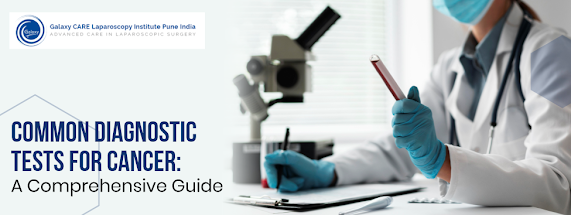COMMON DIAGNOSTIC TESTS FOR CANCER: A COMPREHENSIVE GUIDE
Introduction: Cancer diagnosis can be a daunting journey, often involving a series of tests and procedures to determine the presence, extent, and type of cancer. These diagnostic tests play a crucial role in guiding treatment decisions and understanding the prognosis. In this comprehensive guide, we'll delve into some of the common diagnostic tests used in the detection and evaluation of cancer.
- Biopsy: A biopsy involves the removal of a small sample of tissue for examination under a microscope. This procedure is often used to confirm the presence of cancer, identify the type of cancer, and determine its aggressiveness. There are various types of biopsies, including needle biopsy, surgical biopsy, and endoscopic biopsy, each suited to different situations and types of cancer.
- Imaging Tests:
- X-rays: X-rays use electromagnetic radiation to produce images of the internal structures of the body. They are commonly used to detect tumors in bones and to identify abnormalities in the chest, such as lung tumors.
- Computed Tomography (CT) Scan: CT scans combine multiple X-ray images to create detailed cross-sectional images of the body. They are useful for detecting tumors, determining their size and location, and evaluating the extent of cancer spread.
- Magnetic Resonance Imaging (MRI): MRI uses magnetic fields and radio waves to generate detailed images of the body's soft tissues. It is particularly valuable for imaging the brain, spinal cord, and organs in the abdomen and pelvis.
- Ultrasound: Ultrasound uses sound waves to produce images of internal organs and tissues. It is often used to evaluate abnormalities in the breast, thyroid, liver, and other organs.
- Blood Tests: Blood tests can provide valuable information about the presence of cancer and its effects on the body. Some common blood tests used in cancer diagnosis include:
- Complete Blood Count (CBC): A CBC measures the number of red blood cells, white blood cells, and platelets in the blood. Abnormalities in these counts may indicate the presence of cancer or its complications.
- Tumor Markers: Tumor markers are substances produced by cancer cells or by the body in response to cancer. Elevated levels of certain tumor markers in the blood may indicate the presence of specific types of cancer, although they are not definitive diagnostic tests on their own.
- Endoscopy: Endoscopy involves the insertion of a thin, flexible tube with a camera and light source (endoscope) into the body to examine internal organs and tissues. This procedure can be used to visualize abnormalities in the digestive tract, respiratory tract, urinary tract, and reproductive organs. Biopsies can also be taken during endoscopy for further evaluation.
- Genetic Testing: Genetic testing is used to identify inherited gene mutations that increase the risk of developing certain types of cancer. These tests can help determine an individual's susceptibility to cancer and inform personalized screening and prevention strategies.
Conclusion: The journey from suspicion to diagnosis is a critical phase in the management of cancer. Common diagnostic tests such as biopsies, imaging studies, blood tests, endoscopy, and genetic testing play vital roles in detecting cancer, determining its characteristics, and guiding treatment decisions. By understanding these diagnostic tools and their significance, patients and healthcare providers can work together to navigate the complex landscape of cancer diagnosis and treatment with confidence and clarity.




Comments
Post a Comment